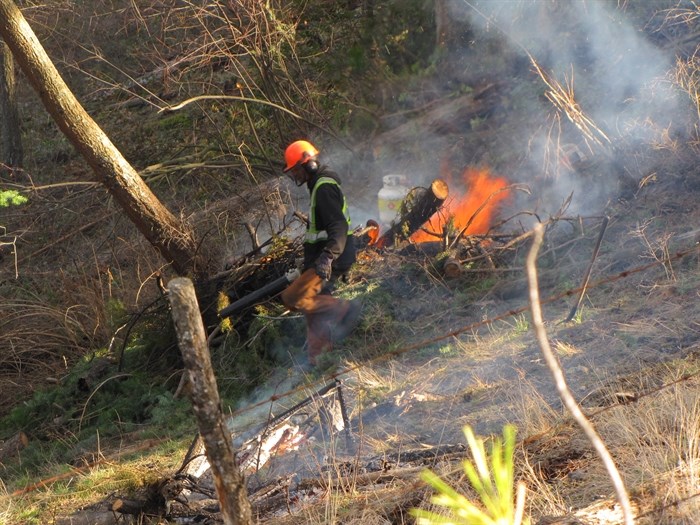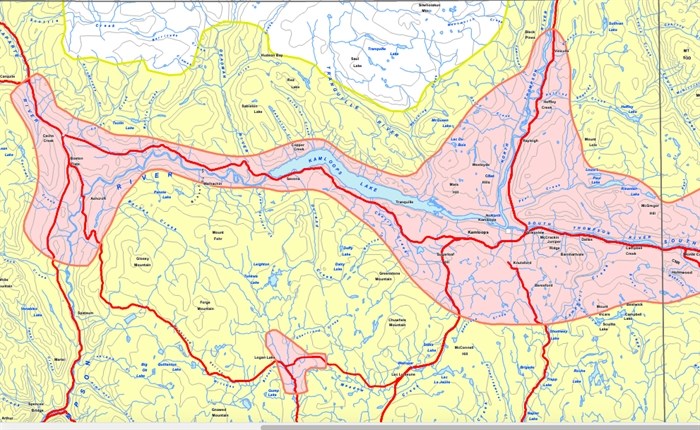
Image Credit: Contributed
December 02, 2021 - 7:00 AM
Heat, fire, smoke, floods and vaccines.
These will be the lasting memories of Thompson-Okanagan residents as 2021 draws to an end.
But it won’t be long before, once again, smoke will be drifting skyward as crews clear forests and burn slash piles in efforts to minimize the risk of catastrophic wildfires next summer.
Some of that burning has already started in the South Okanagan with slash fires in the Penticton area in November.
READ MORE: Expect to see smoke, flames from large controlled burns in Penticton-area
Such wildfire mitigation efforts come at a cost. Initially there’s the noise pollution from chainsaws and equipment clearing and chipping brush. Then there will be smoke as debris piles are burned, which is referred to as open burning.
“Wildfires are bad but it’s also a balancing act,” Trina Orchard, air quality meteorologist with the provincial Ministry of Environment, told iNFOnews.ca. “Open burning can smoke out entire valleys. We’ve seen it happen on multiple occasions when things have gone wrong.
“Yes, we want to get those things burned to protect properties and protect where people are during the summer but it also has to be done carefully because we don’t want to smoke people out the rest of the year when we’re already dealing with wildfire smoke in the summer. It is a bit of a rock and hard place, that’s for sure.”
Work started this week on 10 parcels of land on Westbank First Nation lands surrounded by West Kelowna. Some of the debris will be chipped but some will be burned.
“Our targets are the ladder fuels, smaller trees, the ones that have needles to the ground,” Dave Gill, general manager of Ntityix Development Corporation that is working with Tronson Logging on the project. “Those are the trees that, if they ever catch fire, the fire moves up those trees really quickly. Then it can get into the canopy of the larger trees above it.”
The idea is to cut out the smaller trees, thin some of the larger ones and chip what can be reached by machinery.
But there are many areas where the chipping machines can’t reach so the best alternative is to stack brush carefully into piles about three feet high and four feet in diameter, Gill explained.
Just like building a well-designed campfire, the piles are stacked in such a way that they can be easily lit, quickly get hot enough to burn with a minimum amount of smoke, then be fed by crews to burn as much additional debris as possible before the end of each day.
But the days on which the burning can be done are limited by a provincially mandated venting index.
“The venting index is an equation,” Orchard said. “It is calculated based on the mixing layer heights and column wind speed.”
In more simpler terms, she explained, a good time to burn is when the air is mixing as it warms at ground level and carries the smoke upwards. It’s also a function of wind speed.
There are 41 venting zones in B.C. with one covering the entire Okanagan and another for the Kamloops region.
There are three rankings on the venting index: low (0-33), medium (35-54) and good (55-100). Burning can only be done when the venting index is in the good range.
But, within those maps, are smoke sensitivity zones. Most of the valley bottoms in this region and areas near communities like Kamloops and Kelowna have high sensitivity rankings.

The light coloured areas inside the red circles are high sensitivity areas, yellow are medium and white outside the circles are low.
Image Credit: Submitted/Province of B.C.
That system was set up by the province and was last updated in 2019.
The Regional District of the Central Okanagan, in 2011, decided that the venting index had to be 65 or more in high sensitivity zones, making it even harder to find days when it’s OK to burn.
In the Central Okanagan, there are an average of 66 days during the burning season between Oct. 1 and April 30 where open burning is allowed.
That doesn’t mean you can always burn on those days, Gill said. He's been doing this kind for work in the region for seven or eight years.
“We often light up a test pile,” he said. “It might be a good venting day but the forecast isn’t always right. If we light a test pile and can see the smoke settling in at ground level or blowing straight in a direction we don’t want it to blow, even if it’s a good venting day, we can’t do it.”
The burning regulations were put in place to minimize the impact on residents of burning slash piles, orchard pruning and other debris.
“Personally, I would like to see a little more flexibility with that," Gill said. “I wouldn’t say using a relaxed venting index but something that allows us to actually get these things burned off while we can. That’s a political decision and that’s outside our scope. We have to work with what we have and the rules that are presently in place and let the fire departments and the politicians discuss the venting criteria. If they can provide a little more flexibility, it would certainly make our lives easier.”
Leaving the debris sitting in nicely stacked piles into the summer is not an attractive option either.
“Then we have these piles sitting around during the heat of summer, and you never know who looks at the pile and says, hey, that looks like it would burn really nicely right now,” Gill said. “It’s that risk of carrying through the summer that we’re trying to avoid.”
Even more difficult to get done is prescribed burning, which is burning material on forest floors. It has to be done at a time when it’s moist enough to keep the fires controlled but it also has to be properly vented.
“With mitigation, it removes a lot of the heavy fuels, a lot of the deadfall, underbrush and stuff like that, which is great,” Alan Hofsink, Vernon’s FireSmart coordinator, told iNFOnews.ca in October. “Prescribed burning is really good because it regenerates and renutriates the soils and eliminates a lot of the weeds and deadfall, small stuff that we can’t clean up.”
By the beginning of October, the tinder dry forests that burned so readily in the summer were soaked by rain and the window for prescribed burning had closed for the season.
READ MORE: How Vernon is planning to get ahead of the next fire season
The dilemma facing those trying to minimize wildfire risk is whether burning rules should be eased in order to do more mitigation work that is aided by fire or to have to endure the huge fire and smoke impact like the summer that just passed.
While slash piles can smoke up an entire valley if things go wrong, it can be short lasting. Orchard said a recent incident in Prince George required an air quality advisory for a couple of days. Air quality advisories ran for weeks this past summer.
And while all smoke is bad, there are differences between open burning and wildfire smoke.
“When you burn stuff for open burning it’s supposed to only be wood debris and plant matter, whereas wildfires can burn houses,” Orchard said. “They can burn other things that produce different types of chemicals. They also burn a lot of damp and wet materials which you’re not supposed to do with open burning and that can lead to higher smoke concentrate, and they’re wider spread.”
READ MORE: B.C. residents can choose when they want their forests to burn
To contact a reporter for this story, email Rob Munro or call 250-808-0143 or email the editor. You can also submit photos, videos or news tips to the newsroom and be entered to win a monthly prize draw.
We welcome your comments and opinions on our stories but play nice. We won't censor or delete comments unless they contain off-topic statements or links, unnecessary vulgarity, false facts, spam or obviously fake profiles. If you have any concerns about what you see in comments, email the editor in the link above.
News from © iNFOnews, 2021